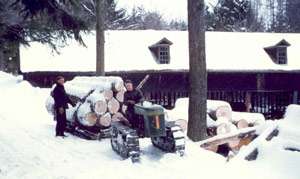
Managing the Legacy Forests at a Birthplace of Conservation
At first glance, the Marsh-Billings-Rockefeller National Historical Park in Woodstock, Vermont, seems like your typical national historic site. The grounds are stately, punctuated by a proper mansion, sprawling gardens, and meticulously maintained outbuildings. Visitors are free to stroll along the trails, take in the views, and cool themselves by a 14-acre pond, known to all as “The Pogue.”
What separates this showy property from other national historical parks is that 472 of the grounds’ 555 acres are actively managed woodland. In fact, this timberland is some of the oldest sustainably managed woodland in North America. When the Rockefeller family made a bequest of the property to the federal government in 1992, they asked that forestry continue on the property. The National Park Service accepted this mandate, even though silviculturally based forest management is rare on federal park land.
Today, this timberland – called the Mount Tom Forest – is managed with three goals in mind: preserving the historic character of the forest; demonstrating the current best practices in forestry; and responding to rapidly changing ecology brought on by climate change, acid rain, and invasive species.
Any one of those goals on its own would prove challenging; striving to achieve them all in concert has been an exercise that has led the park staff and their partners to dig deeply into the mindset of the people who originally shaped the land.
In the Wake of Sheep Farming, Forestry Takes Root
In 1869, Frederick Billings, an entrepreneurial Gold Rush lawyer and partner in the Northern Pacific railroad, bought the Marsh mansion high on a hill above his childhood home town of Woodstock. Billings inherited not just the home but also the philosophical tenets of the previous owner, George Perkins Marsh, the author of Man and Nature and a seminal force in the creation of the modern environmental movement.
Billings crafted a broad vision of social improvement and rural recovery based on reforestation, agricultural improvement, and conservation. This was not an easy task in late-nineteenth-century Vermont, where the soil was depleted and eroding after centuries of what we now know to be unsustainable agricultural practices.
“Billings saw the economic potential of forests to revitalize towns before the profession of forestry was even established in the United States,” said Christina Marts, the park’s resource manager.
Billings planted Norway spruces – recommended by top scientists of the day for their economic potential and by landscape designers for their aesthetic qualities – in plantations and also as individual landscape elements around the mansion. He also constructed miles of carriage roads, not only for recreational purposes but also so the public could visit and learn about his reforestation techniques, in the hopes that they would then use them on their own homesteads.
When Mary French, Billings’ granddaughter, and her husband Laurance S. Rockefeller inherited the property, they continued the legacy of sustainable forest management. They worked with their forester, John Wiggin, who improved the standing hardwoods by rigorously removing poorly formed trees (used mainly for firewood) at a time when the practice was often prescribed but rarely accomplished. Given that head start, the National Park Service has inherited – and is able to exhibit to today’s visitors – some of the best examples of mature, well-stocked, and well-managed hardwood forests in the Northeast.
Stands of native hardwoods make up 320 acres of the park’s 555-acre expanse. Some hardwoods are remnants, either of tended woodlots that date back to Marsh’s tenure or of unmanaged wetland and streambank areas; these remnant areas hold some of the oldest trees in the park. Some unusual natural forested communities exist in these forgotten backwaters, including red maple-black ash swamps.
Most of the hardwood stands grew up naturally on abandoned fields and pastures, as they have done all across New England and New York. The resulting forests are mostly even-aged stands of sugar maple, white ash, and American beech, some interspersed with relics of nineteenth-century homesteads, such as apple trees. Many of the hardwood stands have been conservatively thinned over decades and are nearing the time when most foresters would consider them to be mature; for each stand, there’s a detailed harvesting plan.
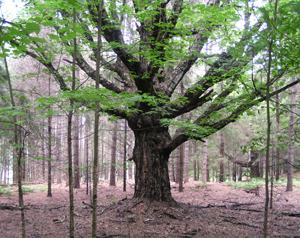
Photo courtesy National Park Service
Throughout the landscape, you’ll find one of the park’s most significant storytelling elements: legacy trees. These massive sugar maples and hemlocks are scattered here and there; they’re the gnarled, limby, hole-pocked storybook trees that defy the lumberman’s tall-and-straight ideals. Legacy trees may not make for good lumber, but they provide food and habitat for many species of wildlife and help conjure an image of the passage of time from field to forest, and from one generation of stewardship to the next.
Legacy trees are one historic feature that the park wants to make sure is always on hand to make the passage of time come alive for visitors. “We’re looking for opportunities to recruit a new generation of legacy trees,” says Marts, mostly by helping strategic candidates along in significant places.
“What we see today is the result of 130 years of management,” says Ben Machin of Redstart Forestry, the park’s consulting forester. “The processes that shaped it will continue to play out, but what you see at any given moment is just a snapshot.” Keeping the essential elements of the snapshot in the frame at all times is the ultimate goal of this team. The picture must always contain legacy trees, along with fields, plantations, and hardwood stands that are marked by a diversity of species, ages, and stand structure.
The Plantation Dilemma
The 152 acres of softwood stands on the property are managed for their historical and interpretive values. Though softwood plantations are not a large part of modern forestry’s repertoire in the Northeast, they’re a vital piece of the park’s historic character. They also require the managers’ most immediate attention, for many of the younger stands are desperately in need of thinning.
In an historical park, managers face choices that would not occur to any other owner of a decadent softwood plantation. For instance, if one of the majestic Norway spruces dies, does the park replace it with another Norway spruce, a non-native species? Or plant a native tree instead? Or is it best to let the new “hole” in the forest regenerate naturally?
Contrast that with decisions about upkeep of the buildings. If the bricks and mortar of the mansion crumble, identical bricks and mortar are used to replace the old. Every bit of the mansion, from the front porch view to the half-used pad of paper in the study, remains essentially the way it was when the Rockefellers walked out the door in 1997. This is historic preservation at its most straightforward.
The dynamic nature of a forest presents an altogether different problem. A tidy red pine plantation far up the flanks of Mount Tom is one place the park is actively trying to reconcile historical preservation with modern forest management. The tall, spindly pines are crowding each other and most other tree and shrub species out. “This stand has absolutely no ecological diversity,” says Marts, a concept that you can literally “hear” in the eerie silence of the understory compared to the busy rustling and singing that go on in the hardwood stands farther downhill. Most birds and other animals prefer complexity of structure, and they don’t find it here.
Marts often finds herself leading tours of the park’s forests. “This is one of my favorite places to talk about the spectrum of considerations that we examined in crafting the forest management plan,” says Marts.
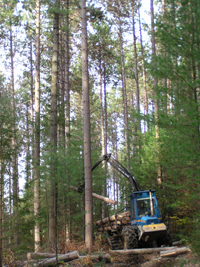
with a modern forwarder.
Photo courtesy National Park Service
The Billings family planted this red pine plantation in 1952, and it’s been thinned several times since then. Before the stand was thinned in 2007 under the park’s recently completed forest management plan, the stand was extremely overstocked, and red pine is particularly sensitive to overcrowding.
“Here you have landscape history on one end, and ecology on the other,” says Machin. “We hope forestry is a tool that can be used to meet both of those objectives.”
Marts said, “There were foresters who were disappointed at our lack of thinning, and others saying this should be kept as a red pine stand as long as possible, to serve as an example of historic management practices into the future.”
That’s just the beginning. “There were some ecologists who recommended that we clearcut and allow the native forest to regenerate naturally. Others said that wasn’t the best ecological approach and recommended a slower transition to accommodate the habitat needs of the salamanders in the adjacent vernal pool,” she adds.
And to top it all off, she says, “There were historic landscape architects who advocated keeping it ‘as is’ to emphasize its cultural and aesthetic attributes,” a sentiment that is shared by visitors, who often like the well-tended, cathedral-like character of plantations.
With all those perspectives at play, what will park managers do? The plan for this stand over the long term is to maintain the edge of the 14-acre plantation for its historical and aesthetic value and its proximity to well-traveled carriage roads, bringing the rear portion into rapid natural hardwood regeneration and allowing the middle to follow course at a slightly slower pace, after the pines have reached maturity.
The Brass Ring of Sustainability
The park is recognized not only for its historic preservation efforts but also for its efforts to meet the highest standards of modern forest management. The key is sustainability, which today can be evaluated through third-party certifiers such as the Sustainable Forestry Initiative (SFI) or the Forest Stewardship Council (FSC). In 2005, Marsh-Billings-Rockefeller became the first national park or national forest in the U.S. to obtain FSC certification of its forest management practices. It is also “one of the first public or private woodland certifications substantially based on preserving cultural as well as natural heritage values,” says Rolf Diamant, the park’s superintendent.
The park’s commitment to sustainability is highlighted by the fact that park-harvested wood is used to serve local community needs. The first major project to follow this philosophy was the construction of a “green” building, the new Forest Center, in 2008. All of the wood for the 1,700-square-foot building is from harvests that were carried out within the park. In the last few years, over 350,000 board feet of red and white pine and Norway spruce has been harvested by local logging contractors.
The new center was raised in an area that was historically used for forestry and wood-processing activities. Red pine was used for its sheathing; the interior was done in white pine (including some massive timbers), Norway spruce, and some hardwoods, all milled locally and kiln-dried in Vermont. The center is heated by a wood-fired boiler fed with park wood. The building, whose purpose is to serve as a gathering place for the park’s education programs, is LEED (Leadership in Energy and Environmental Design) platinum certified. In 2008, it received a Designing & Building with FSC Award from the Forest Stewardship Council.
Pens and bowls made from certified, park-harvested wood are sold through the gift shop. Park wood is also used for National Park Service awards, for in-park building and remodeling projects, and to make furnishings for the visitor center. Marts and her colleagues would like to find even more ways to use the wood locally to further illustrate the connections between responsible forest management, authentic craftsmanship, and sustainable communities.
Laboratory and Classroom
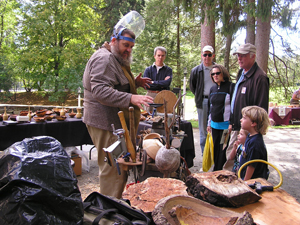
shares his craft and passion for “found” wood with park visitors.
Photo courtesy National Park Service
Sharing their philosophy of sustainable forestry with the public – through workshops, tours, and outdoor laboratories – is truly integral to the park’s purpose and development. “Education is at the core of our mission,” says Marts. “We manage not just for the sake of management, but rather to broaden the discussion of conservation stewardship with diverse audiences.”
And public participation results in valuable feedback that helps guide the park’s decision making. Working Woodlands workshops, A Forest for Every Classroom, and collaborations between local teachers and park staff are all part of the park’s larger educational network.
A Forest for Every Classroom (FFEC) is a program that uses the park’s resources expressly for teacher education. Teachers enrolled in the year-long professional-development program use the park to develop hands-on curricula that encompass the concepts of ecology, sense of place, stewardship, and civic responsibility.
Working Woodlands workshops are held throughout the year in cooperation with the Vermont Agency of Natural Resources and the U.S. Forest Service. They bring together landowners and forestry professionals to explore topics as diverse as crop-tree release, low-impact harvesting tools, milling techniques, trail maintenance, GPS skills, and invasive plant control.
For workshop participants such as Put Blodgett, president of the Vermont Woodlands Association, it’s important that the historical significance of the park is given its due.
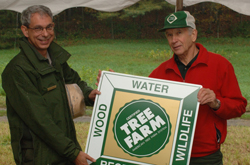
president of Vermont Woodlands Association.
Photo courtesy National Park Service
“Billings was doing the very first planned forestry in America. This is the first tree farm in Vermont. The land’s managers are among the pioneers in forestry – in Vermont and in the U.S. – and they don’t get enough credit for that,” he says.
“But the park, as opposed to smaller organizations, has the wherewithal and the facilities to demonstrate good, sustainable forestry practices and to share them with the public, and to show us what people take for granted about forestry: that forests provide clean air and water and also provide us with the forest products – the books, magazines, pencils, computer paper, firewood, door frames – that we all use.”
History Comes Full Circle
The park, it seems, is also in the business of storytelling: maintaining an overall sense of place and distinctive historic character while also recognizing that, though their translation of the narrative that created this place may not always be literal, it will always be genuine in spirit and execution.
“There is a mandate to invent an entirely new kind of park,” said Vermont author John Elder in his dedication speech at the opening of the park in 1998. “It must be one where the human stories and the natural history are intertwined, where the relatively small acreage serves as an educational resource for the entire National Park Service and a seedbed for American environmental thought; and where the legacy of American conservation and its future enter into dialogue, generating a new environmental paradigm for our day.”
Above all, the park’s staff and partners need each other and the broader community with a stake in Mount Tom’s future to add their voices to the unfolding tale. Being the first national park required to keep its forests in active management is not an easy task. “We’re still learning,” says Diamant, “and this is about continual education and dialogue.”

